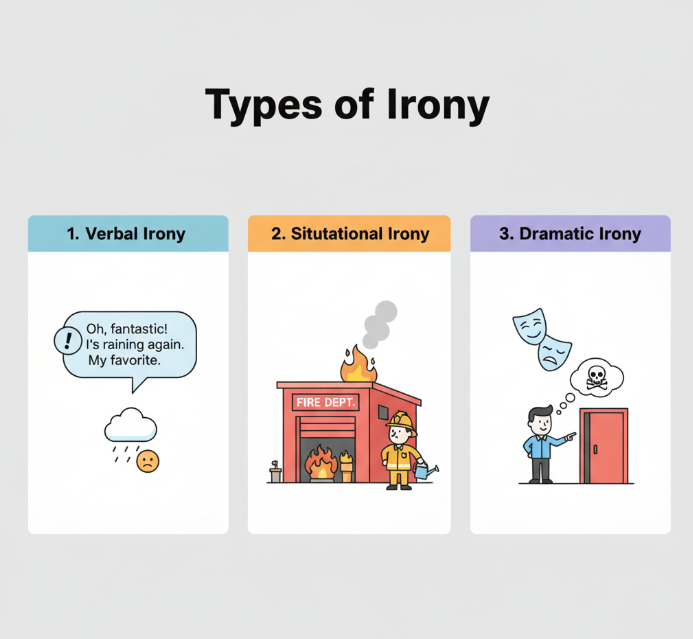Introduction: Why Humor Matters in English
If your English conversations are all grammar drills and vocabulary lists, congratulations—you sound like a robot. But real-life English isn’t just about simple sentences and verb tenses. It’s full of jokes, wordplay, and sarcasm so dry you could use it as a towel.

Humor is one of the biggest cultural doors you can walk through. Miss it, and you’ll always feel like the outsider nodding politely while everyone else laughs. Get it right, and suddenly your small talk feels natural instead of forced.
This guide will walk you through three essential English humor tools—puns, sarcasm, and irony—so you don’t just “understand the words,” you actually get the joke.
Puns: When Words Refuse to Behave
A pun is a wordplay joke that uses double meanings or similar sounds to create humor. Puns are silly, clever, and sometimes painful—but that’s the point.
Classic Pun Example
- “I’m reading a book about anti-gravity. It’s impossible to put down.”
Here, the phrase “put down” works both as “stop reading” and “set something on the floor.” That’s pun magic: one phrase, two meanings, a groan, and maybe a smile.

Why English Speakers Love Puns
English is riddled with homophones, phrasal verbs, and words that moonlight with multiple meanings. It’s basically a pun factory. That’s why they pop up in advertising slogans, newspaper headlines, and even Shakespeare’s plays.
If you’ve ever wrestled with phrasal verbs, you already know the language is slippery. That slipperiness is exactly what makes puns possible.
How to Get Better at Puns
- Grow your vocabulary. You can’t make wordplay if you don’t know enough words. (Check out this gamified vocabulary guide to level up.)
- Notice context. If something sounds weird or “off,” it might be a pun hiding in plain sight.
- Practice. Try making jokes with objects around you. Coffee mug? Easy: “This brew is grounds for happiness.”
Sarcasm: Saying the Opposite, With Style
If puns are playful, sarcasm is the slightly mean older sibling. Sarcasm is saying the opposite of what you actually mean, usually with a tone that screams, “I’m not serious.”
Sarcasm in Action
- Your friend shows up 30 minutes late. You say, “Oh, right on time!”
No one’s fooled. The meaning is the opposite.
Why Sarcasm Is Hard for Learners
The words alone don’t give it away. You need to hear the tone—the exaggerated flatness, the fake enthusiasm. Without that, sarcasm can fly over your head. That’s why understanding intonation and emphasis is basically step one.
Cultural Notes
Sarcasm is beloved in English-speaking countries, especially in the UK and the US. But not every culture appreciates it. In some places, sarcasm feels like an insult rather than a joke. So use it with caution unless you want to practice your apology skills.
Tips to Handle Sarcasm
- Tone is everything. Flat, exaggerated, or overly cheerful voices usually signal sarcasm.
- Watch for mismatch. If words don’t fit the situation (“Lovely weather” during a thunderstorm), it’s probably sarcasm.
- Test it out slowly. Start with TV shows (The Office is basically a sarcasm bootcamp—here’s the IMDb page).
Irony: The Universe’s Favorite Joke
Irony is broader and sneakier than sarcasm. It’s about the gap between expectation and reality, and it comes in three main flavors.

The Three Types of Irony
- Verbal irony – Saying one thing but meaning another. (Sometimes overlaps with sarcasm.)
- Example: “Fantastic, another traffic jam!”
- Situational irony – When the outcome is the exact opposite of what you’d expect.
- Example: The fire station burns down.
- Dramatic irony – The audience knows something the character doesn’t.
- Example: We see the villain hiding in the closet while the hero walks in clueless.
Why Irony Feels So… English
English speakers love irony because it creates clever twists in stories, movies, and everyday conversations. Shows like Friends or news satire programs like The Daily Show rely on it constantly. If you can’t spot irony, you’ll miss half the jokes.
How to Train Your Irony Radar
- Watch comedies and sitcoms. (Yes, binge-watching counts as studying.)
- Practice storytelling. Irony shines in anecdotes, and using discourse markers makes your timing sharper.
- Don’t force it. Bad irony sounds awkward, like someone explaining their own joke.
Practical Ways to Learn English Humor
Humor isn’t a skill you read once and “install.” You have to practice, make mistakes, and occasionally deliver a joke so bad your friends pretend not to know you. Here’s how to get started:
- Watch sitcoms. Friends, Brooklyn Nine-Nine, or The Office—each teaches you something about sarcasm, puns, or irony. (Friends on IMDb is a good start.)
- Listen to stand-up comedy. It’s a masterclass in timing, sarcasm, and cultural references.
- Shadow dialogues. Mimic lines from comedy shows to get the rhythm and tone. Our shadowing technique guide can show you how.
- Experiment with friends. Safer audience, less judgment. Strangers? Save your practice for later.
- Stay culturally aware. What’s hilarious in one country can be offensive in another.
Conclusion: Humor Is the Shortcut to Connection
Mizah (yes, Turkish friends, that means humor) isn’t just a bonus—it’s a survival tool in English-speaking spaces. Whether you’re making small talk, navigating a work meeting, or trying not to look clueless at a party, humor helps you blend in.
So try a pun. Detect sarcasm without looking confused. Spot irony before it runs past you. And if your first attempts flop? Congratulations—you’re officially learning like the rest of us.
Your turn: Watch a comedy tonight, catch one pun or sarcastic line, and drop it in the comments. Don’t worry—I’ll only judge you a little.
